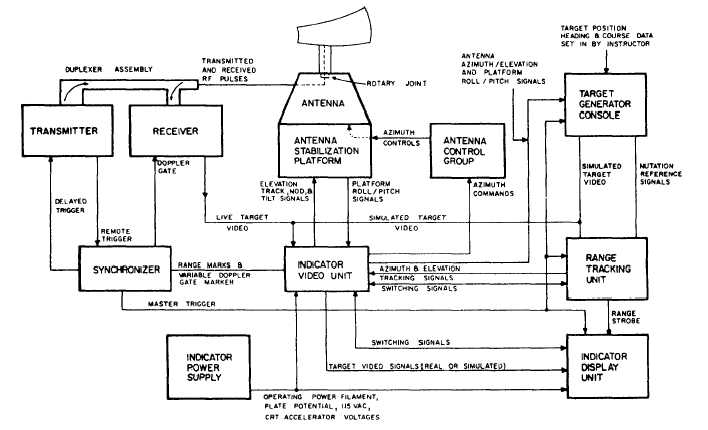In the on-line mode, the sensor station 3 keyset
generates primary control signals, which are
processed through the central computer, logic unit
No. 1 (LU 1), and the RIU. The antenna control
provides signals to control the radar scan functions
and tilt servo loop stabilization. The two radar
control boxes control the sensitivity time adjustments,
receiver gain, fast time constant, automatic frequency
control, and video test of the respective RT.
FIRE CONTROL RADAR
Learning Objective:
Recognize operating
modes and system controls used in a fire
control radar.
The 11D13A radar maintenance trainer device is
discussed in the following text. This system was
selected because an actual operational system would
require that classified information be included.
Because the trainer is different from an operational
system in some respects, these differences are noted
when discussion will not violate security regulations.
The 11D13A trainer device includes all the
elements essential for basic search radar
ranging —transmitter, receiver, antenna, and
synchronizer circuits. Additional elements, including
tracking, stabilization, and target generation
(simulated targets), allow operation as either a fire
control (intercept) radar or a bomb director radar. The
target generator unit, although not usually contained
in operational radar systems, produces a
three-dimensional target that is controllable in
azimuth, range, and elevation in a manner typical of
analog computing systems. It contains both
mechanical and electronic elements found in analog
computing systems. A block diagram of the trainer is
shown in figure 3-9. The ranges in the trainer vary
from 0 to 80,000 yards. An actual weapons control
radar has much longer ranges, which are normally
expressed in miles.
OPERATING MODES
The 11D13A trainer is capable of operating in
three basic modes-search (PPI), fire control, and
bomb director. Fire control is divided into five
Figure 3-9.-Trainer 11D13A functional block diagram.
3-9



